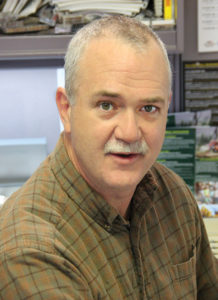Oregon Facing Danger Signs
Article by Dan Shell, Senior Editor, Timber Processing April 2024
 The state may be the top U.S. lumber producer right now, but log supply in Oregon the past 30 years or so has been an uneasy balance of private, federal (Forest Service and Bureau of Land Management) and state timberlands. Now, with state and private timber owners taking a regulatory harvest reduction, it’s more important than ever for federal officials to meet—and ideally increase—timber harvest levels to help maintain that balance.
The state may be the top U.S. lumber producer right now, but log supply in Oregon the past 30 years or so has been an uneasy balance of private, federal (Forest Service and Bureau of Land Management) and state timberlands. Now, with state and private timber owners taking a regulatory harvest reduction, it’s more important than ever for federal officials to meet—and ideally increase—timber harvest levels to help maintain that balance.
Officials with the American Forest Resource Council (AFRC) are sounding the alarm after three mill closures announced in Oregon this year: Hampton Lumber’s Banks mill, Interfor’s Philomath mill, and a two-year sawmill closure announced by Rosboro in Springfield while a new glulam plant is being constructed. In all three cases, the companies involved cited ongoing uncertainty over log supply as contributing to the closure decisions.
Also adding to raw material concerns is the ongoing impact of Oregon’s September 2020 wildfires that burned 971,000 acres of timberland and destroyed 15 billion BF of green timber with more than $30 billion in end-product value, according to an Oregon Forest Resources Institute report.
AFRC President Travis Joseph and organization members are urging the Pacific Northwest congressional delegation to take steps to help reverse the trend of more mill closures. This includes more active oversight to ensure the FS and BLM meet and increase timber harvest goals.
Maintaining a healthy and robust forest industry sector is also a key component of addressing federal forest health and wildfire issues. An additional $6 billion outlay to the FS and BLM to increase the pace and scope of forest treatments and stewardship projects hasn’t yielded an uptick in log supply that traditionally accompanies such projects, Joseph says, noting that the BLM’s western Oregon timber sale program this year has been arbitrarily reduced by more than 25%.
The group is also taking the long view on the issue of maintaining a vibrant forest industry sector. The cautionary tale is Arizona, where years of federal forest management neglect allowed forest industry infrastructure to almost disappear. And now, the state is still struggling to develop the timber processing and utilization facilities to make a difference in forest health operations.
There’s also the role of wood building materials and other wood products that sequester carbon permanently and help decarbonization efforts. It’s a sustainable industry that produces sustainable products.
Joseph adds: “If the Federal Government is going to be successful in addressing the current federal forest health and wildfire crises – and protect the extraordinary social, environmental, economic, and cultural values of our public lands – it must sustain and grow the forest infrastructure and related workforces.”
Latest News
Georgia-Pacific Contributes To Atlanta CLT Project
Georgia-Pacific is partnering with Jamestown, SmartLam North America and the Georgia Forestry Foundation to support construction of the first Georgia-grown mass timber project, 619 Ponce. Delivery of the first beams arrived at Ponce City Market in Atlanta where vertical construction began on the four-story mass timber loft office building…
Roseburg Announces Massive Investment
In a much-anticipated announcement, Roseburg Forest Products revealed in last week its plan to invest $700 million during the next four years to upgrade and expand its manufacturing operations in southern Oregon, including the construction of a MDF facility in Dillard, current site of multiple operations and where the company was founded nearly 90 years ago…
Single-Family Housing Starts Show Strength
U.S. housing starts had a minor dip in March, at 1.42 million, down 0.8% from February, though single-family starts were at a rate of 861,000 in March, an increase of 2.7% from February, while multi-family (five units or more) were 542,000, down 6.7% from February, according to the U.S. Census Bureau and U.S. Dept. of Housing and Urban Development monthly new residential construction report…
TP&EE Sets 2024 Show Dates
Hatton-Brown Expositions LLC announces that the next Timber Processing and Energy Expo (TP&EE) will be held September 25-27, 2024 at the Portland Exposition Center in Portland, Ore. The 2024 show will be the sixth biennial TP&EE to be produced since 2012 by Hatton-Brown Expositions, LLC, an affiliate of Hatton-Brown Publishers, Inc. and of Timber Processing, Panel World and…
SYP Lumber Shipments Shattered Records In 2022
Shipments of southern pine lumber recorded an increase in 2022 from the previous year for the 13th consecutive year, according to the Southern Forest Products Assn. (SFPA), which tabulates shipment totals with the Southern Pine Inspection Bureau (SPIB) and Timber Products Inspection (TP). The 2022 total also…
Find Us On Social
Newsletter
The monthly Timber Processing Industry Newsletter reaches over 4,000 mill owners and supervisors.
Subscribe/Renew
Timber Processing is delivered 10 times per year to subscribers who represent sawmill ownership, management and supervisory personnel and corporate executives. Subscriptions are FREE to qualified individuals.
Advertise
Complete the online form so we can direct you to the appropriate Sales Representative.
